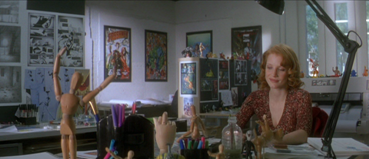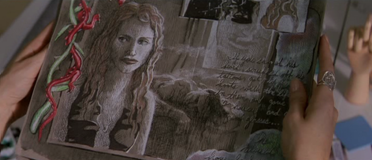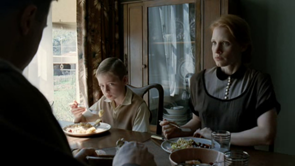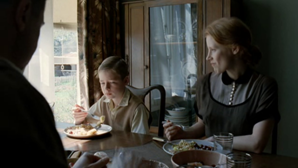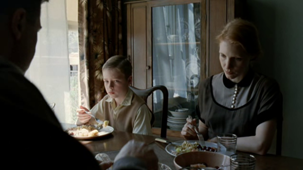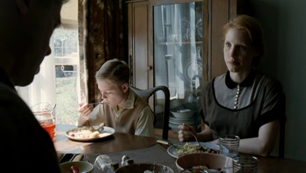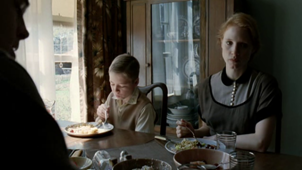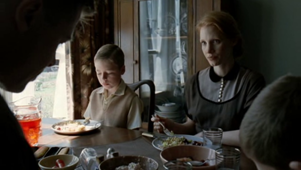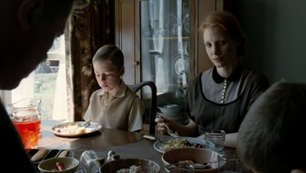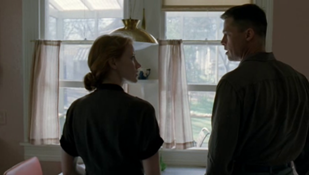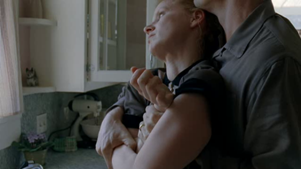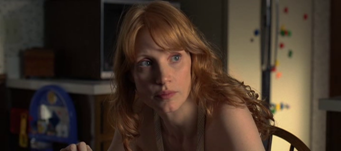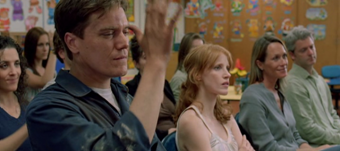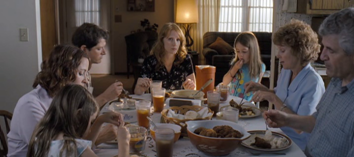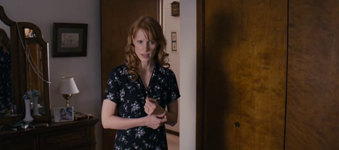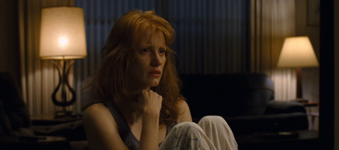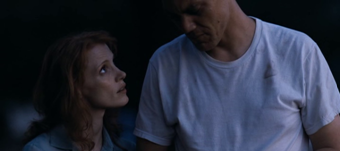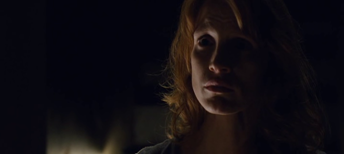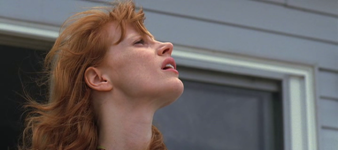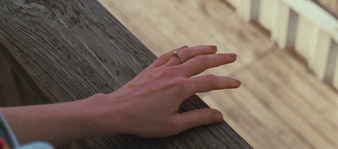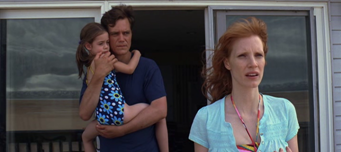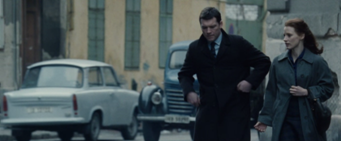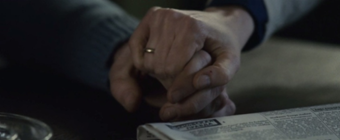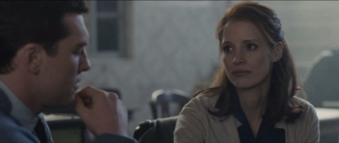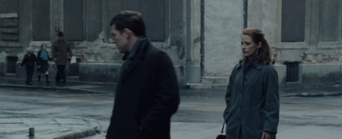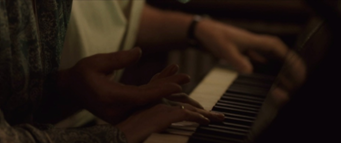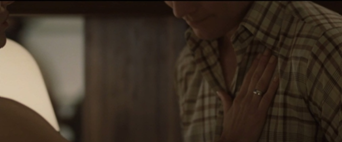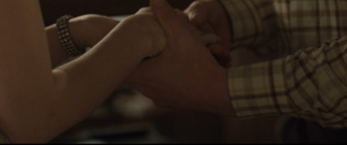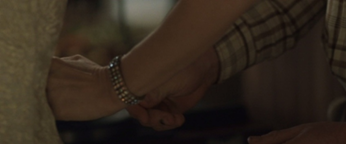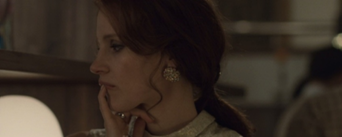The Actor’s Vision: Three Performances by Jessica Chastain
Steven Rybin
In E.L. Doctorow’s short story, “Jolene: A Life,” there is the following passage:
Cindy had an eye for Jolene right from the beginning. She gave her cigarettes to smoke outside behind the garbage bins, and she knew hair and makeup. She said, Red—Jolene had what they call strawberry hair, so that, of course, was her nickname—Red, you don’t want to cover up those freckles. They are charming in a girl like you, they give your face a sunlight. And see, if you keep pulling back your hair into ponytails your hairline will recede, so we’ll cut it just a bit shorter, so that it curls up as it wants to, and we let it frame your sweet face and, lo and behold, you are as pretty as a picture.[1]
Jessica Chastain starts here. Of course, years of training and acting work in theatre, in dance, and on television precede her performance as Jolene (Dan Ireland, 2007), the film adaptation of Doctorow’s story. The small roles on television, especially, already indicate her striking presence and intense emotional shorthand. But these parts are reactive, not active. On a 2004 episode of E.R., she plays the delusional, abused daughter of a stroke victim, stilled into shock as the controlled chaos of a trauma center orbits around her; in a 2005 installment of Veronica Mars, playing a runaway living in fear of a violent boyfriend, she disappears after the first five minutes.
As Jolene, though, she is in all but one scene. Did this mean that Chastain’s character had achieved narrative agency? Not quite. In the Doctorow story, Jolene—a fifteen-year old foster child when we meet her, in her twenties at the end—is abused by her stepfather, and subsequently moved from one foster home to another. She is looking for love, but is repeatedly subject to the victimization of men (and one woman) who take her as their prize. Cindy, in the passage above, is only one of several characters in the story who tries to possess Jolene, to frame her like a picture, rather than let Jolene frame herself.
However, throughout the short story and its film adaptation, Jolene will develop an interest in art. In the film, her paintings and drawings suggest her gradual discovery of the means by which to articulate her vision of the world, rather than subjecting herself to the vision of others:
Whether or not Jolene finally achieves an independent vision is uncertain in the Doctorow tale, for the author suggests that his character is about to make the same mistake again. Rather than having Jolene remain settled in her new career as an artist of graphic novels that tell her story, Doctorow ends the narrative with Jolene’s dreams of becoming a Hollywood movie star:
Friends tell Jolene she could act in movies, because she may be twenty-five but she looks a lot younger … I mean, why not? Jolene says to herself. She has this daydream. Her son sees her up on the screen one day. And when takes herself back to Tulsa in her Rolls-Royce Silver Cloud he answers the door and rushes into the arms of his movie-star mother.[2]
A trip to Hollywood would mean peril for Jolene, one more adventure in objectification. However, the film’s version of this scene cannot help but function as a prescient allegory for the career of its lead actress. As Chastain voices Jolene’s words (lifted, more or less verbatim, from Doctorow’s story), she walks away from the camera, and along the Hollywood walk of fame, in control of her future:
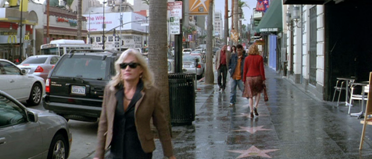
One can be forgiven for forgetting about Jolene at this moment, and for instead imagining Chastain walking, some decades hence, on her own star. This desire for agency, of a victory over the male gaze and a film industry dominated by men, is often found in writing on actresses, including autobiographies by actresses themselves.[3] As it turns out, in the final frame of this film, Chastain herself is walking towards better movies than Jolene—films that enable her to articulate a vision of her own rather than subjecting her to one.
But how can someone as new to cinema as Jessica Chastain already be said to possess a “vision”? For most cinephiles she is best known for her role as Mrs. O’Brien in Terrence Malick’s The Tree of Life (2011); this celebrated appearance in the work of a director known to engage with large philosophical issues would be reason enough to take her seriously. Yet her career already includes more than Malick. Her other memorable appearances in 2011 included Take Shelter (Jeff Nichols), The Debt (John Madden), Coriolanus (Ralph Fiennes), The Help (Tate Taylor), Texas Killing Fields (Ami Canaan Mann), and, more recently, Lawless (John Hillcoat, 2012), Zero Dark Thirty (Kathryn Bigelow, 2012), and Mamá (Andres Muschietti, 2013). Indeed, a recurring critical trope in journalistic pieces on Chastain in 2011 was the seemingly sudden appearance of a fully-formed body of work.[4] A distinctive screen presence and also something of a chameleon, Chastain creates vivid depictions of singular characters with rich inner lives. Consider the variety of problems, actions, and situations her characters grapple with: motherhood and marriage (The Tree of Life, Take Shelter, Coriolanus); retribution and national politics (The Debt; Zero Dark Thirty); relationships between men and women (all the films, but felt especially in The Tree of Life, Take Shelter, The Debt, and Texas Killing Fields); racism (The Help); the environment (Take Shelter); mental illness (Take Shelter); and, in the case of Malick’s film, the very meaning of life itself.
Chastain, then, has quickly become something more than Hollywood’s latest starlet. The seriousness of the subject matter tackled by these films is one reason. Her background is another: trained at Juilliard, with the benefit of a scholarship provided by Robin Williams, she is also the veteran of recent theatrical productions co-starring Al Pacino, Philip Seymour Hoffman, and John Ortiz.[5] And the impressive range of directors she has already worked with—from established filmmakers such as Malick, Hillcoat, and Bigelow, to relatively more mainstream Hollywood craftsmen like Madden and Taylor, to emerging independent directors such as Nichols and Mann—offers a varied set of contexts for her performances.
What I am claiming for Chastain, then, is the ability, as an actor, to enact a vision of the world. This is a large claim for a young actor, particularly one who works in an industry that values persona over performance and commodity stardom over acting ability. In her star study of Nicole Kidman, for example, Pam Cook shows that Kidman struggled for respectability early in her career, finding widespread mainstream recognition as an accomplished actress only with the receipt of an Oscar in 2002, for The Hours.[6] Crucially, as Cook points out, Kidman’s desire to be recognized as a serious actress was not first articulated through her films, but in an appearance in a Vogue photoshoot in 1994, in which she assumed the look of various classical Hollywood stars such as Marlene Dietrich and Lana Turner.[7] Of course, Chastain’s career has not lacked for publicity appearances, and in photoshoots she has evoked the guises of actresses such as Tilda Swinton and Lucille Ball. [8] However, Chastain’s public persona has also emphasized her education and training, as well as her desire to place herself in a lineage of actors not only in terms of physical appearance, but also in terms of ability and skill. For example, she has mentioned her admiration for other performers past and present, such as Greer Garson and Isabelle Huppert, in various interviews.[9] Certain biographical details, repeated in various interviews, also amplify her attitude toward acting as a profession and a craft. These include her anecdote of her experience watching a theatrical production of Joseph and the Technicolor Dreamcoat as a child and subsequently discovering that acting was a profession that she might one day attempt.[10] Another motif of Chastain’s various interviews is her tendency to frame her experiences working with seasoned actors (such as Al Pacino in Wilde Salome, Helen Mirren in The Debt and Vanessa Redgrave in Coriolanus) as “master classes,” pedagogical experiences that do not simply satisfy a will to become a star but rather teach her about technique and improve her ability as an expressive artist.[11] Her definition of the actress as a life-long student of the profession was made explicit in a September 2012 New York Times interview in which she claims to study the work of other actors who have tackled similar roles in the past as a method to improve her own work. In the same interview, she also describes the value of watching her own dailies during film productions.[12]
Chastain’s discursive framing of acting as an ongoing pedagogical experience provides a frame for understanding the various guises the actress assumes on screen and in various public appearances. This persona deemphasizes the persona itself in favor of the profession. That an actor should want to be known as a serious artist first and a star second is, of course, not unfamiliar. One is reminded of Lauren Bacall’s autobiography, By Myself (1978), in which she claims personal agency over the narrative of her career by spending as much time describing her later experiences on Broadway as she does reflecting upon her iconic pairing with husband Humphrey Bogart.[13] Bacall’s book is typical of autobiographies by actresses in its writerly claim of agency over a career often subject to (male) forces beyond her control.[14] But regardless of the suspicions of claims to an “authentic self” often voiced in scholarly work on stardom and performance, there is enough evidence to take Chastain seriously when she claims an interest in acting over stardom. [15] For example, in early 2012 she turned down a presumably lucrative opportunity to appear in Iron Man 3 (Shane Black, 2013) in order to make a pair of low-budget independent films and to rehearse, over the summer of 2012, for her Broadway debut in The Heiress later that year.[16] Of course, the circulation of Chastain’s public persona, constructed out of various interviews, red carpet appearances, and photoshoots, does not give us access to the “authentic” person any more than Nicole Kidman’s persona does. But it does establish her serious regard for the craft and artistry of acting not as something achieved later in a career after stardom has been attained but as an authentic point of departure for understanding the career to come. Chastain, in other words, does not need to wait to write her autobiography to claim agency over her life story; she has, at a very early moment in her career, claimed agency as an actress by discursively placing herself as an artist whose learning process continues even after her stardom has been attained.
So Chastain wants to learn. But what does she teach us as cinephiles? In the balance of this essay I want to show, through close analysis of three performances, that what Chastain is beginning to create, at a very early moment in her career, is nothing less than an oeuvre, a vision—the same kind of vision Jolene might like to attain through the making of art, but which Chastain is in a better position to accomplish because of the skill and complexity of her first performances. Discussions of “visions” in film studies are usually limited to film directors, but what would it mean to credit an actor with a vision? The actor’s vision might be understood as a process of thought, emotion, and action that unfolds gradually on film: not a way of being looked at, but a way of looking, glancing, and gazing at the world around her, and conveying meaning through this gaze. When engaged with the vision of an actor, in turn, viewers become attuned to two levels of moment-by-moment decision-making: the choices made by actors in the embodiment of their characters and the choices made by the characters themselves as they shape their lives and destinies. In watching film performances, the viewer is witness to the subtle gradations of a character’s existence: the movements, gestures, expressions, and looks that make up the life and choices of a character, actions that in turn resonate within a larger filmic and narrative structure.[17]
How, then, should cinephiles engage with this expression of inner life and existential direction, which is the goal of the sort of commitment to the acting discipline that Chastain’s persona embodies? As Andrew Klevan has noted, the film actor often brings us into intimate contact with “moments of suspension,” those passages in films in which a character’s life might go in any number of directions. “The suspended moment,” Klevan writes, “prevents us fixing our interpretations and it opens up possibilities. The performer resists asserting a single emotional response, and allows us to wonder at the different stories available to his character.”[18] Klevan’s analytical frame also lets us understand, with great precision, a character’s action as embodied in the existence of the character in a very particular social, familial, or institutional situation.
Such analysis leads to a detailed, descriptive engagement with the performer’s gestures and the larger filmic context in which those gestures resonate with meaning. It is through the viewer’s work of engaging with her choices—and through the film’s work of giving her a place in which such choices might be valued—that an actress becomes more than an object of another’s vision. Achieving an agency of her own, she helps create the filmic structure achieved through collaboration with directors and fellow actors attuned to what she might bring to the screen. Thus, as Klevan has also noted, analyzing film acting involves “an intimate moment-by-moment engagement with surrounding structures,” urging us to look closely at performances that “inhabit an appropriate place.”[19] It is in this “appropriate place,” different for every film, that the actor articulates both her vision as an artist and the inner lives of her characters.
Three of Chastain’s most interesting early films—The Tree of Life, Take Shelter, and The Debt—show how she works in harmonious tandem to create different kinds of “appropriate places” for her character. In her best films, her performances are not simply happening in space but rather help create our sense of the space of the world her character inhabits, and what is at stake in that space. David Edelstein writes of Chastain in Take Shelter: “It’s…how she moves, how her dancer’s body physicalizes emotion, in this case her love for her daughter (through her fervent signing) and the fear of her husband’s escalating mania. She can tense a muscle and change the space.”[20]
The vision Chastain embodies in these films should again be emphasized as existential and lived. As an actor in her best films, she invites us to follow her character’s present-tense life of moment-by-moment action. The fact that she is relatively new to cinema foregrounds the lived nature of her vision as a performer, subject to further accumulation, complexity, revelation, revision, and learning as future films are released. Chastain’s evolution as an actor, indeed, is already indicated by the extent to which her recent work has quickly eclipsed both Jolene and her earlier television appearances.
The Tree of Life and the glance
“I think he’s the last silent film director.” – Jessica Chastain on Terrence Malick.[21]
Actors in Terrence Malick’s films are often noted for their voice-overs.[22] What is just as interesting in Malick, however, are the passages in which actors are very nearly silent. Malick’s films, in fact, are often compared with the work of silent director F.W. Murnau, so it should not be surprising that his actors are called upon to use subtle expressions, absent of dialogue, as part of their repertoire.
One of the most quietly effective expressions available to the film actor is the glance. The glance is less salient than the gaze. An actor’s gaze will frequently motivate a corresponding point-of-view shot that fixes what her character is looking at (in an eyeline match) into the larger discourse of the film. Through her gaze, we will learn of the assertions she makes toward people and objects. A performer’s gaze is, in other words, assertive: it demands recognition of a precise emotion, not as a fleeting contingent detail, but as an agent in the film’s narrative drive. A glance, by contrast, often does not show us what the actor is looking at. Instead, it is often glimpsed outside the circuit of shot-reaction shot structures, and is very quick, so much so that our first viewing often fails to locate the glance in the larger narrative structure of the film. The glance can also quietly suggest a sensitive alternative or counterpoint to more forceful characters and can serve as an indication that things in this world might be otherwise. While presently lacking the strength to articulate its meaning in its social world, the glance is perhaps all the more powerful to viewers for its subtlety.
In one moment in The Tree of Life, the O’Brien family sits down for dinner. The mother (Chastain) is joined by the father (Brad Pitt) and their three sons (Hunter McCracken, Laramie Eppler, and Tye Sheridan). As the scene proceeds, Mr. O’Brien commands the conversation, as Pitt displays a key trait of his character: at once a rigorous disciplinarian, he is also at times a tender father who nevertheless resists betraying any outward sign of that tenderness. But after one of his sons baits him with a taunt, Mr. O’Brien explodes in rage, marshaling his oldest son into a closet while grabbing the offending son by the ear.
For the longest shot in this sequence, however, we are focused neither on Pitt (who is dimly lit in the foreground, on the left side of the frame) nor on the offending son, but on Chastain, whose glances quietly measure her responses to her husband’s actions and words. Such glances are perhaps just like those we can remember from family dinners, in which disagreements between parents were often registered silently, never quite rising to the level of explicit discourse. When Mr. O’Brien commands the youngest son to do what he says, Chastain’s glance quietly registers her disapproval of his sternly authoritative tone:
Upon her son’s obedient response, however, the corresponding glance at the boy is one of unconditional approval and love, in keeping with her attitude towards her children throughout the film:
After Mr. O’Brien cruelly instructs his young son to not speak, his wife’s next glance demonstrates another shade of her sensitivity. Her love for her family, it seems, renders her unable to directly confront her husband about his cruelty. She defers to his authority, glancing at him only briefly before looking down at the table:
Chastain’s next two glances repeat the earlier pattern, with a subtle variation. After deferring at first, she then takes another wide look at her husband…
…and she then tries to defuse the tension Mr. O’Brien has created at the table with this sideways glance at her son:
This glance is a perfect expression of something The Tree of Life depicts throughout: the secret, loving bonds that individual parents will often achieve with their children without the other parent’s full, conscious awareness. It is difficult to capture the emotional register of this last glance in a still frame, for Chastain conveys Mrs. O’Brien’s emotion through the quietly graceful movement of her eyes, a movement that indeed must be quiet and subtle in order to convey its secret meaning to her child. Looking at her son here, it is almost as if Mrs. O’Brien says to him, “It is okay. That is just your father, being your father; love will prevail, and this will pass.”
But just as Mr. O’Brien is not quite a complete tyrant, Mrs. O’Brien’s measure of her husband is complex. Affectionately turning his attention to his youngest son, he refers to him, lovingly, as “my fine feathered friend,” a rare moment of unguarded affection. He then gently instructs him to sit up in his chair—he has read about posture in the paper, he says. Mrs. O’Brien now glances at her husband with tenderness. She approves his now somewhat more measured, and well-intentioned, discipline (good, rather than cruel, to his child). This is the man who is still worth loving…
…and then she gives another sideways glance, in loving approval of her son’s dutiful obedience to his father’s wise parenting (good for his health, this time):
These glances are as delicate as one might expect from a Malick film. Their secret power comes through the freedom he has given his actors to find such moments. Chastain says that Malick encouraged her to think of herself as a “co-director.”[23] The result of such instruction is felt in the way these glances direct us to the emotional subtext her character brings to the scene, as well as her character’s various existential possibilities. Will she continue to be an unconditionally loving mother, keeping the family’s civilized veneer intact? Will she challenge an authoritative husband? Or, somehow, will she do both? The power of these glances is impressed upon us by Chastain’s performance in the context of the sustained attention in this shot on her reactions to her husband’s words. (In a film full of quick, impressionistic images, this image lingers for a relatively lengthy thirty seconds). The quiet emotion at play in these glances remains with us even as the emotional tenor of the scene shifts abruptly as the family dinner devolves into an argument between the O’Brien couple over the perceived misbehavior of one of the children.
Later in the scene, after the argument at the table has ended the dinner, Mrs. O’Brien courageously attempts to transform her glance into a more powerful, challenging gaze. She approaches her husband with a rare assertiveness:
But when their gazes finally meet, it is he who overpowers her. Crucially, Mr. O’Brien turns her to face the opposite direction, engulfing her physically, but more importantly, turning her eyes (eyes that have registered, and then, to her children, conveyed, the emotional truths of this family scene) away from his. Malick and Lubezki’s framing of this moment eventually settles into a medium shot of Chastain that cuts Pitt off at the neck, focusing not on his power but instead on her glance—still full of its resistance to her husband’s domineering attitude—outside the window:
Chastain’s glances in the first part of this scene never reach the level of narrative discourse. Her performance as a whole is completely in tune with Malick’s own rejection of linear narrative in favor of carefully gradated poetic modulations. The culmination of the scene, in her lingering glance outside the window, makes her earlier glances all the more poignant. In The Tree of Life Chastain creates a character as graceful and as delicate, but also as complex and sensitive, in her responses to the world around her as is Malick’s cinema itself.
Take Shelter and the gaze
Most films do not look and sound like Terrence Malick films, of course, and with Take Shelter, Chastain finds herself performing in a more conventional narrative. Nevertheless, the film, directed by Jeff Nichols, contains a wealth of striking visual imagery that poetically draws the viewer directly into the consciousness of its protagonist, Curtis (Michael Shannon). Curtis, whose mother suffers from a mental illness, begins having nightmares and waking dreams of raging storms. He fears he has perhaps inherited his mother’s affliction. The opening shots of the film, which frame Shannon looking at a terrifying tornado, are ambiguously suspended above reality and dream. The subsequent image of Curtis in the shower might lead us to assume the tornado was a dream (this is how the director himself interprets it).[24] Yet the opening images are never firmly established as purely subjective, given the elliptical cut that joins the first two scenes. The reality status of Curtis’s visions is thus established as a question that the rest of the film will explore.
In Take Shelter Chastain plays Curtis’s wife, Samantha. She is a much more outwardly assertive and less metaphysical character than Mrs. O’Brien. Sam is not concerned with abstractions such as “nature” and “grace,” words we hear in the Malick voice-overs. She is instead worried about concrete, everyday things such as money, health insurance, and her young daughter’s upcoming surgery. Chastain’s performance registers this difference in nuanced ways. Sam gazes directly at Curtis, demanding honesty and forthrightness in their marriage. This clearly establishes Sam as a post-feminist woman (in Malick’s vision of the 1950s, Mrs. O’Brien could not have plausibly behaved this way, or at least not for very long). Indeed, one of the most striking images of Chastain in the film is an intense gaze that snaps Curtis out of a fog after a particularly bad nightmare:
This gaze at her husband—a demand for his attention to his family—becomes a motif in her performance throughout the film. We see the assertiveness embodied in it again later after Curtis’s preoccupation with his apocalyptic visions prevents him from filling familial duties. After he nearly misses their daughter’s sign language class, Sam is upset at her husband. At the appointment, the class learns the sign for the word “father,” an outstretched palm to the forehead. Quietly implying her disappointment with the father of her own child, Sam perfunctorily gestures the sign, and then lowers her palm with palpable irritation; she folds her arms, as if unwilling to fully “speak” the word “father” in light of her lingering resentment toward Curtis:
This lovely moment is quietly funny; it understands how couples privately communicate silent meanings to one another in public spaces (an idea that resonates all the more strongly here, given that they are learning sign-language in the scene). Later, in a similar moment, Curtis will take time out of his workday to visit a hardware store, where he begins his plans to build the shelter that he will use to protect his family from the raging storms he sees in his visions. This unplanned trip results in his tardiness to a family dinner. The tension of the moment is embodied in Chastain’s most admonishing gaze in the film:
As the mise en scène suggests, for Sam, the stability of the family is at stake in Curtis’s erratic behavior. Her gaze at him is a silent demand that he comply with normative social life. But as Curtis’s visions get worse, his nightmares become more intensely physical, disrupting the placid surfaces of family life. Later, Curtis will wet the bed after a particularly nightmarish dream. We are embarrassed for him as he pleads with Sam not to come closer, for fear she will notice. Here it is Shannon who is doing the glancing, for his character is unable to inscribe what he sees in his nightmares into any kind of social discourse (or even any kind of intimate discourse with his wife, the one person he should be able to tell). By contrast, Sam gazes at him, showing concern but calling for him to clearly articulate what he is experiencing. Emotionally, we are still at one remove from her here (Chastain is seen in medium-long shot whereas Shannon is kept in close-up); her tacit demand that he keep the beat of normative family life is distant from our own vivid sharing of his nightmarish visions:
As Nichols and Shannon reveal on the film’s DVD commentary track, Chastain was often worried that her character would be perceived as cruel and misunderstanding during such moments. (She initially resisted the idea that Sam should slap Curtis later in the film after he loses his job, for example).[25] The complexity of her performance, however, lies in its ability to keep her character suspended, throughout the first half of the film, above at least three distinct narrative paths: Sam might accept that her husband has a mental illness; or she might see what he sees, thus confirming the reality of his visions; or she might leave him in light of the extreme and not entirely forthcoming measures he takes to ensure his family’s safety in light of his visions.
Without losing any of her power and strength as a character, then, Sam’s gaze, now colored by the salient emotional concern she feels for her husband, becomes suspended over a variety of narrative possibilities that hold the future of her family in the balance. The special power of this next gaze, after Curtis has fully explained what he has been going through to his wife, is that it is tear-stained; this gaze acknowledges the pain Curtis himself has gone through, but does not lose its earlier strength and assertiveness. If anything, her strength is more intense here, despite the tears:
Even though the perspective of Sam is always understood, the viewer identifies with Curtis and his visions. We are not quite sure if they signify an authentic vision of a crumbling world or simply the byproduct of a mental illness (or, in the likeliest case, some combination of both); but we see them too, so on some level they are undeniable. We see, and possibly accept, the truth of his visions before Sam does, but the final act of the film reconciles her vision with her husband’s. Accepting him back after he loses his job (he has illegally borrowed equipment from his construction job to build the storm shelter in his backyard), Sam, having learned that she has appeared in his nightmares, asks if he can continue to accept her as a part of his life. For the only time in the film—right before Curtis asks Sam is she is going to leave him—Chastain glances down as she talks to her character’s husband. Her gaze, momentarily broken, casts genuine doubt on the future of their relationship:
Assured by Curtis that he can handle her presence in his nightmares, she walks over to him. In a medium shot, Chastain restores Sam’s strong gaze:
Later, during a violent storm, Sam, Curtis, and their daughter retreat to the storm shelter. Curtis refuses to leave the shelter long after the storm has passed, fearing his apocalyptic visions have become a tangible reality. Sam tries to convince Curtis to open the door to the shelter and walk through it with the three of them, but he is convinced it is not safe to do so. In some of the most moving shot-reaction shots in recent American cinema, Sam pleads with Curtis to open the door, emphasizing that it is important that he do it. At this point, her gaze is no longer compelling him to conform to a socially normative mode of conduct. Instead, it demands that, whatever he is going through, he go through it with Sam and his daughter. This demand, a tough love, is the accumulative substance of Chastain’s performance in the film. Now shrouded in the same darkness Curtis has felt, Jeff Nichols provides a harmonious structure for Chastain’s performance through low-key lighting:
In the final scene, Sam’s gaze confirms the reality of Curtis’s visions. In The Tree of Life, Mrs. O’Brien’s vision of the world only finds its discursive, social dimension on the voice-over track and in the silent glances that she impresses upon us and her children (what she says about grace and nature is never spoken to her husband). But Sam’s confirmation of her husband’s vision is stitched into the narrative discourse of the film and the salient emotional reality of the family. First, she gazes at the coming storm…
…then, down at her hand:
The final piece of this puzzle is Sam’s acceptance of what Curtis has seen as a reality. Chastain squints as the wind blows through her hair. Her character will have to readjust her vision:
In classical American films, the woman’s acceptance of the man’s worldview was often a deferral to his moral code. But Chastain’s strong gaze, even as the storm reduces it to a squint, is as assertive here as it was earlier in the film. Her character does not give her strength or authority over to her husband; instead, she retains her strength and authority and accepts his vision of the world not simply because he has seen it, but because she now sees it too. Chastain’s performance, in tandem with Shannon’s own fine work and Nichols’s elegant filmmaking, conveys the emotional substance of this decision acutely.
The Debt and hands
In contrast to the previous two films, The Debt is a familiar kind of genre film, an espionage thriller; it takes as its subject the pursuit of a former Nazi doctor by three Mossad agents working undercover. Nevertheless, Chastain’s performance, in concert with Sam Worthington, develops an intriguing motif involving the use of both actors’ hands. Her work in this film adds another element to our discussion of her expressivity. If the glance and the gaze are crucial to her vision in the other films, in The Debt the physical gestures with which the character engages with the social and ethical questions in the world around her become especially salient.
Chastain plays Rachel Singer, one of three Mossad agents enlisted to kidnap and return to custody a former Nazi doctor, Vogel (Jesper Christiansen), so he may stand trial for war crimes. She is joined by two other agents, David Peretz (Sam Worthington) and Stephen Gold (Marton Csokas). However, the attempt to kidnap Vogel goes wrong, and the three agents are unable to deliver Vogel across the border. Temporarily keeping Vogel in a safe house until they can figure out what to do next, the doctor eventually escapes after he taunts David to anger with a series of anti-Semitic taunts. To save the face of Israel as a nation, they intend to lie and say they killed Vogel as he tried to escape. The three characters live their life with this lie, as conveyed in a frame story in which we see older versions of the three agents played by Helen Mirren, Ciáran Hinds, and Tom Wilkinson.
When we first see the younger Rachel, however, we are not quite sure of her relationship to David. After she crosses a border checkpoint, the two pretend to be lovers, but it soon becomes clear that they are meeting one another for the first time. Their ruse is a part of their espionage. As the narrative proceeds, however, a bond develops between the two of them, as the personal stakes in this mission for both characters (who have lost loved ones in the camps) become clear. These stakes stand in contrast to Stephen’s political goals, centered around the moral value of capturing Vogel in abstract nationalistic terms.
Vogel works as a gynecologist. Rachel, posing as a patient, visits his office with David, who waits outside during her visit. The two hold hands, posing as a couple as they walk. While sitting in the examination chair, Rachel takes pictures of Vogel with a concealed miniature camera. After she leaves the doctor’s office with her pictures, she meets David outside. The two again hold hands, posing as a couple. But whereas earlier they had parted hands at the same moment, David now pulls his hand away first. But her hand is still open, painfully and emotionally vulnerable. She is suspended above professional duty and personal feeling:
She quickly returns her hand to her jacket pocket. In the next scene, however, she passes the micro camera to David with a gesture and expression that once again shift the emotional balance towards the personal. Grasping his hand—with the ring on her finger, we are reminded of the marriage to David that is never to be—she places the camera in his palm…
…and then gazes at him with the same emotional vulnerability as before. As so often in Chastain’s films, the man is looking down, not up, a failure to meet the challenge of her strong vulnerability with his own:
This pattern of oscillation between a personal code of morality and a professional, nationalistic code of conduct is at the heart of this motif, and indeed is the central emotional interest of The Debt as a film. The pattern works itself out as images of hands chart the failure of Rachel and David to connect on a personal level beyond their shared passion to bring Vogel to justice. Later, after a final visit to Vogel’s office before the kidnapping, David pulls his hand away from Rachel’s once again. This time, Chastain stops as Worthington keeps walking, motivating the return of his hand to hers:
David, however, is ultimately unwilling to pursue a personal relationship with Rachel, remaining steadfast in his commitment to capturing Vogel and bringing him to justice in Israel. David’s oscillation allows Stephen to step in, manipulatively taking advantage of Rachel’s heartache with a stroke of her hand at the piano:
After the kidnapping of Vogel fails, and several months after the three commit to the lie about the Nazi doctor’s death, the young versions of Rachel and David are together one final time at a party. At this point, Rachel and Stephen are married; but it is clearly only a political union. David tells her he is leaving both Mossad and Israel; he is unable to carry on with the ruse that they are national heroes. She begs him to stay, placing a hand on his heart:
He, in turn, grasps Rachel’s hands and asks her to leave her loveless marriage with Stephen, and Israel itself, and come with him:
Rachel is called away from the conversation by partygoers commenting on a picture of her with Stephen. As she turns around to greet them, she pulls her hand away from David, pushing it toward her body, a gesture that prefigures the solitary nature of the older Rachel’s mission in the final half-hour of the film:
The memory of this missed opportunity and unforgettable moment will haunt her future, and the emotional traces of what she has left behind seem to linger on her fingers:
The Debt depicts this hand motif mostly in close-ups. The significance of gestures in close-up is often devalued in work on film performance. Most descriptive appreciations of screen acting tend to value the relatively longer shots and longer takes of classical Hollywood films, in which a certain amount of space was granted to performers. Andrew Klevan, for example, privileges styles of film that emphasize the ontological equality of the actor with decor, props, and setting, an aesthetic requiring the actor to harmonize her performance with other filmic elements and thus inhabit an appropriate place.[26] In such a style, the close-up, rather than becoming the primary vehicle for the performance, tends to inflect what is established in longer shots. What makes these hand gestures in The Debt so moving, however, is that they are never able to find this appropriate place. The “long shot” of Israel (its national politics) cannot include Rachel and David’s personal connection. Their unrequited intimacy is at odds with the politics of the nation and only felt in their fleeting moments of touch. This is, after all, the couple that should be together, for their moral commitment goes beyond the present agendas of national institutions; it understands the deeply personal need to bring Vogel to justice. While the method of intensified continuity editing at work in The Debt may seem to fragment the performances at times, these gestures nevertheless still resonate legibly. The film, when taken alongside her other work, also demonstrates Chastain’s impressive ability, at a very early moment in her film career, to convey emotional ideas in a wide variety of filmic contexts.
In all of these films, Jessica Chastain emerges as an especially striking actor worth taking seriously, given the serious subject matter of her films and the acute sensitivity of her first performances. Her work thus far is indeed so impressive that one might wonder what she has left to learn. But as her public persona reminds us, she remains devoted to the idea of acting as both craft and pedagogy. As she goes forward, she will no doubt continue to educate the sensibilities of cinephiles attuned to her vision.
Published on December 3, 2012.
Notes
[1] E.L. Doctorow, “Jolene: A Life,” The New Yorker, 23 December 2002, 106.
[2] Ibid, 113.
[3] See, for example, Viv Gardner, “By Herself: The Actress and Autobiography,” in The Cambridge Companion to the Actress, eds. Maggie B. Gale and John Stokes (Cambridge: Cambridge University Press, 2007), 173-92.
[4] See, for example, Liz Braun, “The Way of Grace,” Movie Entertainment, February 2012, 14-16, and Anthony Breznican, “Why This is the Year of Jessica Chastain,” Entertainment Weekly, 2 September 2011, 58-9.
[5] Her appearance on stage with Al Pacino in a production of Oscar Wilde’s Salome has been documented in Pacino’s film Wilde Salome, which played at film festivals in 2011 and early 2012. She appeared off-Broadway in a production of Othello with Ortiz and Hoffman in 2009.
[6] Pam Cook, Nicole Kidman (London: British Film Institute, 2012), 59-61.
[7] Ibid, 19-20.
[8] See, for example, Cath Clarke, “Jessica Chastain,” in An Other (Spring/Summer 2012), 338-351, which channels Ball; and “The New Guard,” in W (May 2012), 110-121, which is evocative of Swinton’s distinctive look.
[9] Lynn Yaeger, “The Importance of Being Earnest,” in The New York Times Style Magazine (April 15, 2012), 63.
[10] Charles McGrath, “Off to Broadway and Back to School,” in The New York Times (September 9, 2012), AR-12.
[11] For Chastain’s references to these experiences, see, for example, Robert Koehler, “Chastain, Fassbender everywhere on big screen,” in Variety.com (Nov 21, 2011), accessible at <www.variety.com/article/VR1118045955>; and Charles McGrath’s September 2012 Times Talks interview with Chastain, accessible at <new.livestream.com/nytimes/chastain>.
[12] See Times Talks interview, in which she particularly mentions an interest in looking at other actresses who have played Catherine Sloper in various film and theater productions of The Heiress. In the same interview, she also discusses certain texts influential on her approach to acting, such as Kristin Linklater, Freeing Shakespeare’s Voice (New York: Theatre Communications Group, 1992).
[13] Lauren Bacall, By Myself (New York: Alfred A. Knopf, 1978).
[14] See Viv Gardner, “By Herself: The Actress and Autobiography, 1755-1939,” in The Cambridge Companion to the Actress, eds. Maggie B. Gale and John Stokes (Cambridge: Cambridge University Press, 2007), 173-92.
[15] See, for example, Pam Cook, Nicole Kidman, 8.
[16] The two films are the diptych The Disappearance of Eleanor Rigby: Hers and The Disappearance of Eleanor Rigby: His, chronicling the break-up of a relationship from the perspective of each partner.
[17] The idea of the viewer’s active engagement with the moment-by-moment inflection of surrounding filmic structures by the actor is a key idea in Charles Affron, Star Acting: Gish, Garbo, Davis (New York: E.P. Dutton, 1977). Andrew Klevan engages with Affron’s ideas on the actor’s role in film narration in Film Performance: From Achievement to Appreciation (London: Wallflower Press, 2005), 11-12.
[18] Andrew Klevan, Film Performance: From Achievement to Appreciation, 13.
[19] Ibid, 3.
[20] David Edelstein, “The End Is Here,” in New York Magazine, 25 September 2011. http://nymag.com/movies/reviews/take-shelter-edelstein-2011-10/.
[21] Quoted in Emma Hardy, “The Secret’s Out,” in Telegraph Magazine, 24 September 2011, 33.
[22] See, for a discussion of the voice-over in Malick’s cinema, Steven Rybin, “Voicing Meaning: On Terrence Malick’s Characters,” in Terrence Malick: Film and Philosophy, eds. Thomas Deane Tucker and Stuart Kendall (New York: Continuum, 2011), 13-39.
[23] Chastain says this on a bonus feature on the Blu-ray disc of The Tree of Life, entitled “Exploring The Tree of Life” (Fox Searchlight, 2011).
[24] This is discussed by Nichols on the commentary track for the U.S. DVD/Blu-ray release of Take Shelter (Sony Pictures Classics, 2011).
[25] See commentary track for Take Shelter.
[26] Many of the frame captures in Klevan’s Film Performance: From Achievement to Appreciation, for example, are of long or medium shots in classical Hollywood films, works that offer the opportunity to analyze the performance in relation to other components of mise en scène.
Steven Rybin is Assistant Professor of Film at Georgia Gwinnett College. He is the author of Terrence Malick and the Thought of Film (Lexington Books, 2011), Michael Mann: Crime Auteur (forthcoming from Scarecrow Press), and co-editor, with Will Scheibel, of Going Home: New Essays on Nicholas Ray in Cinema Culture (forthcoming from the State University of New York Press).

